That's TBD, pending WFH and RTO.
Between the massive shift to employees working from home (WFH) across many industries and the so-called Great Resignation — a 2021 phenomenon that reportedly has millions faced with return-to-office (RTO) mandates resigning to search for greater workplace flexibility — there’s a lot of angst to talk about at the business and industry (B&I) foodservice watercooler these days. Well, there would be, if we were in the office chatting at the watercooler or at the corporate cafe’s stir-fry station or coffee bar.
The reality is that plans for a big RTO push this fall, loosely coinciding with the resumption of in-person teaching, began unraveling as the pandemic’s highly contagious delta variant staged a late-summer surge. In August, employers large and small began announcing pushbacks of their RTO schedules — some by a month, some by several months, some indefinitely. It’s a scenario that once again demanded adaptability and flexibility on the part of all stakeholders, including corporate dining, a hard-hit foodservice segment.
Thanks to COVID-19’s WFH edicts, the business and industry segment saw a 55% decline in both operator and consumer spend, according to Datassential’s “2021 Segment Recovery Guide: B&I.” That’s compared to the research firm’s 2020 pre-COVID-19 performance estimate for the segment. The overall estimated impact for restaurants, by comparison, was a decline of 27.9%. Only travel and leisure losses surpassed that of B&I, with an estimated decline of 56.7%.
Segmented by type of B&I account, the impact was worse for office building (white collar) accounts, which saw sales decline at an estimated 70.1% (actual versus pre-COVID-19 forecast). For manufacturing or warehouse accounts (blue collar), sales declined 48.5% in 2020.
For 2021, the research firm forecasts improvement in operator spending on food, nonalcoholic beverages and packaging of 7.1% for white-collar B&I accounts compared with 2020 levels, and 17.1% for blue-collar accounts. “B&I will improve, but it will have a long way to go, and it’s all dependent on how soon office buildings can reopen and get their people to return to commuting,” notes Mark Brandau, group manager at Datassential.
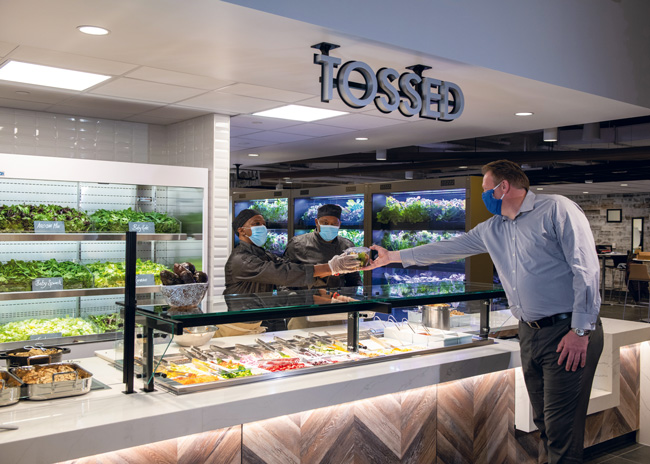 While mobile ordering has become an important component of B&I foodservice, FLIK Hospitality sees pent-up demand for traditional cafe-station operations as employees return, in some cases modified away from self-service models. Images courtesy of FLIK Hospitality Group
While mobile ordering has become an important component of B&I foodservice, FLIK Hospitality sees pent-up demand for traditional cafe-station operations as employees return, in some cases modified away from self-service models. Images courtesy of FLIK Hospitality Group
Back, But Different
For their part, B&I foodservice operators are ready and waiting to provide a warm welcome back, playing a strategic role in helping to ensure employees feel safe and good about returning to the office. They’ve been working hard during this unprecedented time of largely empty offices to get ready for that return and for new-normal customer expectations.
“B&I is back to a degree, but it’s not a facsimile of what it was. It’s a different business model, driven partly by technology and partly by new workplace realities,” says Scott Davis, president of FLIK Hospitality Group and 2021 IFMA B&I Silver Plate winner. As of early July, Davis said FLIK anticipated being back to 85% capacity (excluding catering) by Oct. 1, but by mid-August those plans had been pushed back by 30 to 90 days, depending on geography.
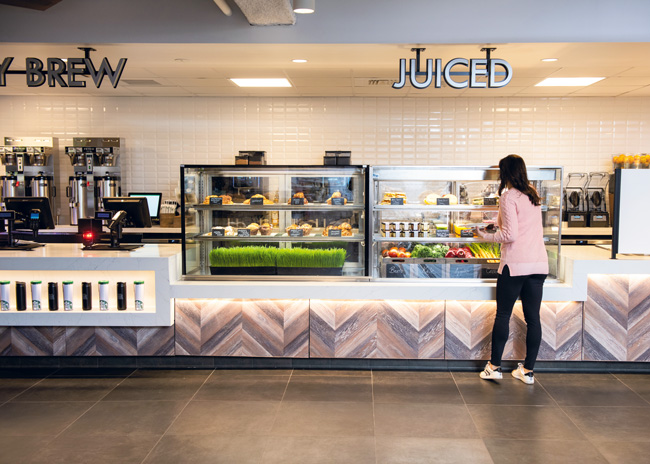 Image courtesy of FLIK Hospitality Group“It’s a moving target that keeps getting readjusted,” Davis says. “Planning over the past 18 months has been pretty intense for how we’ll eventually be welcoming our consumers back, because while our people are engaging the consumers, we still have masks in place and new rules to follow. So how we’re engaging the consumer is different than it was before.”
Image courtesy of FLIK Hospitality Group“It’s a moving target that keeps getting readjusted,” Davis says. “Planning over the past 18 months has been pretty intense for how we’ll eventually be welcoming our consumers back, because while our people are engaging the consumers, we still have masks in place and new rules to follow. So how we’re engaging the consumer is different than it was before.”
Among the biggest changes across the board, Davis says, is that now nearly all of the company’s clients offer customizable, self-checkout ordering via phone for pickup in the cafe or delivery to a convenient location. “If you hadn’t incorporated that experience before, now it’s pretty much a requirement,” he notes. “Even when we offer free lunch, which most have been doing for essential workers, people are asked to scan their food. That’s not necessarily to see what the value of the meal was but to get comfortable with the technology. The value proposition in hospitality is driven in large part right now by technology-enabled experiences.”
What returning employees won’t see changed, at least at FLIK-managed accounts, is the breadth of menu variety offered, according to Davis. Unlike in many commercial segments, where menus have been streamlined during COVID-19, FLIK’s operations continue to offer something for everyone, from simple grill and deli staples to global cuisines. “We have stations every day that serve Mexican, Latin, Indian foods,” he says. “They’re quick-service, but the authenticity of ingredients and preparations is there. That’s definitely continuing, and the sheer variety and quality is what keeps employees staying in their buildings.”
From a service perspective, while mobile options are critical add-on features, Davis also sees pent-up demand for otherwise normal operations once employees return. That includes customers heading back into the cafes to graze and make their selections and once again utilizing traditional stations. Those stations, he adds, may be modified to avoid utensil sharing, and some clients have opted to convert self-serve salad bars to tossed-to-order salad stations, but they remain in high demand.
Technology also figures prominently in RTO foodservice programs at insurer Florida Blue, a subsidiary of the GuideWell family of companies. The firm was set to welcome back 10% of its workforce beginning in early July, with the goal of having 50% back by October. As of mid-August, those plans have been put on hold, according to Damian Monticello, senior director of hospitality services. Due to Delta variant surges, he says, “we’re holding at the 10% mark. We haven’t made a decision yet on if or when our return-to-office process will resume this year.”
Pre-COVID-19, Florida Blue served some 11,000 people per day in office locations in Jacksonville, Fla.; Miami; and Mechanicsburg, Va. Its main campus in Jacksonville represented the bulk of that, with roughly 7,000 people served daily via full-service, marketplace-style cafes, limited-service cafes and micromarkets. From March 2020 through July of this year, the total population served across those three locations was cut to 500 to 600 critical infrastructure employees, with the balance on work-from-home status.
During that time, foodservice was reduced accordingly. Monticello, who also serves as current president of the Society for Hospitality and Foodservice Management, says Florida Blue’s program operated on “skeleton mode,” providing complimentary boxed breakfast and lunch to essential employees who would order via mobile app for pickup. Already in development before COVID-19, rollout of the company’s new Eatify mobile ordering system was quickly accelerated.
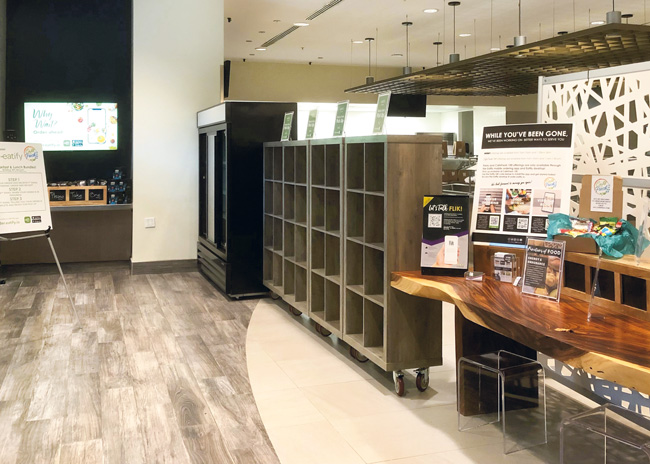 Florida Blue promotions tout the company’s new mobile app, Eatify, and new menu concepts, some of which will only be available online, as part of its strategy to build return-to-office excitement. New pickup areas have been added to Florida Blue’s foodservice venues to provide employees with quick, safe and convenient access to orders placed via mobile app. Image courtesy of Florida Blue
Florida Blue promotions tout the company’s new mobile app, Eatify, and new menu concepts, some of which will only be available online, as part of its strategy to build return-to-office excitement. New pickup areas have been added to Florida Blue’s foodservice venues to provide employees with quick, safe and convenient access to orders placed via mobile app. Image courtesy of Florida Blue
“We took advantage of the past 16 months to hit the reset button,” Monticello says. “We sat down with our provider to talk about what we want our program to look like, what works, what doesn’t, what efficiencies we can build in now when we have the time and the access to the spaces.”
What Monticello and his team want Florida Blue’s programs to look like by the time the company fully welcomes employees back reflects popular existing elements, fresh menu concepts and tech-enabled systems. With that initial phase of 10% of employees headed back to the office in mid-summer, Florida Blue was set to expand its operations to a new iteration of its full-service offerings.
“Instead of employees coming down to the cafe, standing in line at a station, placing their order, waiting for the food and then standing in a cashier line, we’ve moved everything to mobile-app ordering,” Monticello says. “Now, everyone orders their food in advance, and they receive notification when it’s ready for pickup. They can either eat in the dining room, which is open at reduced capacity, or take it back to their desk.”
The new system, Monticello adds, helps avoid scenarios in which employees congregate in cafes and helps the foodservice team manage its offerings, operations and labor more efficiently. Rather than the previous station-based production model, all orders are now produced from a single area in the kitchen. And orders are prepared as they come in versus relying on batch-production models driven by historical data, which Monticello says inevitably resulted in leftovers or wasted food. “With this system, we can still offer multiple unique concepts on any given day, but they’re all being produced by the same team of four or five people rather than needing two or three people per station to make that happen,” he says.
For employees, an additional benefit of the mobile app system is the ability to schedule when they’d like to pick up their meals, much like many have become accustomed to being able to do at home for delivery. “We looked at what we ourselves were doing as consumers, and how we saw restaurants adapting during the pandemic,” Monticello notes. “We tried to formulate our program by thinking more like a restaurant than a traditional employee-feeding operation.”
That mindset extends to embracing ghost kitchens and virtual restaurants as well. During the pandemic, Monticello’s group developed three new concepts: The Chicken Grill, Down Home and Napoli Pies. Florida Blue will introduce others as in-office populations rise. Some may eventually have a physical presence in the cafes, but several will continue as virtual brands available only via the app. The strategy, inspired by similar moves made by restaurants, further expands the ability to offer variety, reduce cafe crowds and speed throughput for time-crunched employees.
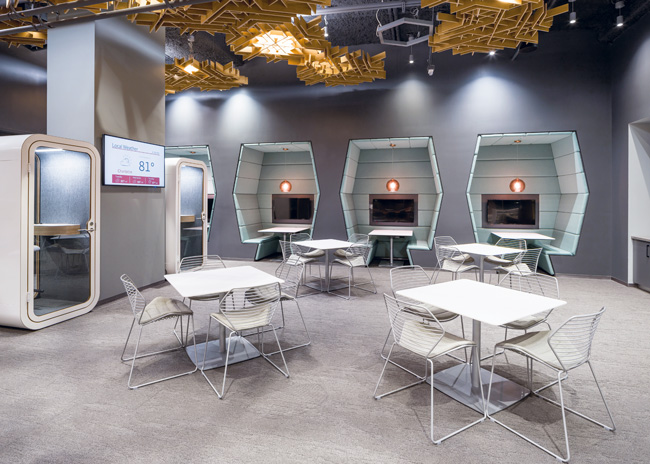 As employees return, Wells Fargo’s amenities team is focused on providing flexible, tech-supported, scalable programs and dining options suited to new hybrid work scenarios and reduced in-office populations. Image courtesy of Wells Fargo & Co.
As employees return, Wells Fargo’s amenities team is focused on providing flexible, tech-supported, scalable programs and dining options suited to new hybrid work scenarios and reduced in-office populations. Image courtesy of Wells Fargo & Co.
New Realities, New Thinking
For most in the B&I foodservice world, flexibility and adaptability have become the biggest watchwords, notes Justin Williams, amenities strategy lead, senior vice president, Corporate Properties Group, at Wells Fargo & Co. He says the need for new and innovative thinking around how corporate dining can meet changing employee needs and evolving workplace environments is stronger than ever.
Wells Fargo, which has 30 cafeterias and more than 20 micromarkets at facilities throughout the country, planned to begin its RTO process on Sept. 7, but by August had pushed it back to Oct. 4. Meanwhile, Williams says the company continues to explore new ideas and adapt to new realities, some of which had begun to impact operations even before the pandemic.
“Our big focus is on ensuring that employees are engaged and supported as we plan out. And we’re looking to build excitement about returning via a range of programs designed to help them look forward to coming back, whatever that might look like,” Williams says. “Even pre-COVID, we were seeing what was becoming a three-day in-office workweek for some employees, with demand on Fridays and Mondays weakening. So what does that look like in terms of what our programs are delivering?”
Part of the answer for Wells Fargo lies in technology — providing the same types of mobile-app ordering employees have gotten used to using while working from home. Pilot testing of such systems has gone well, Williams says, and development continues. Other tech-based features in the works include online classes and chef demos, providing tips for easy meal planning and preparation as employees resume juggling their commutes and office life.
The company is considering bringing back family-style take-home meals, which were received well pre-COVID-19; possible partnerships with third-party meal-kit providers; and integrating pop-ups by local restaurant operators (facilitated via its vendors) into its cafes. Williams sees such pop-ups as a viable way to support local businesses, offer variety to employees and keep cafe spaces dynamic even while at reduced capacity.
In the long term, Williams says the company may rethink physical spaces dedicated to foodservice. “At many companies, we’re seeing a fragmenting of the traditional model, and that’s interesting,” Williams says. “Instead of one large cafeteria that everybody comes to, there can be multiple foodservices of different styles throughout the building and in outdoor spaces, placed near flexible, open work areas that are more in-line with how people work today. These are all ideas we’re looking at.”
Concepts such as ghost kitchens are on his radar too, as well as a strategy for reducing real estate needs and costs. “Let’s say we have an office of 2,000 people, which maybe we wouldn’t consider adding foodservice to because of the cost of build-out, staffing and maintenance,” Williams says. “But if you have a partner who can bring food in, that changes the dynamics. Suddenly, we have the flexible scaling we need in this environment and new possibilities for how to serve our employees. B&I foodservice is certainly not dead, but we’re about to see a whole new rebirth and reiterations of how these operations work.”
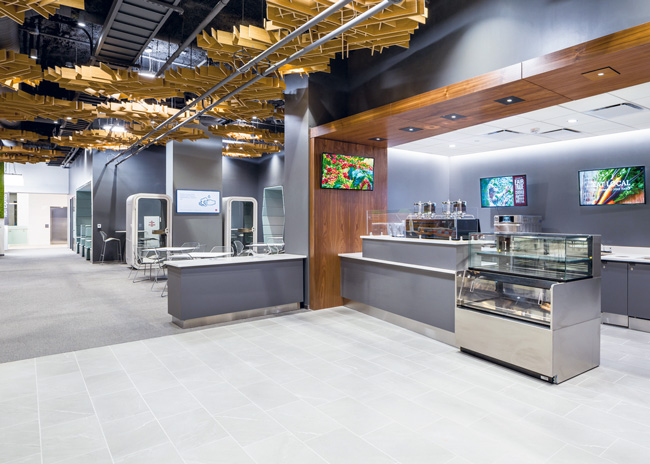 Image courtesy of Wells Fargo & Co.
Image courtesy of Wells Fargo & Co.
Challenges Ahead
Compounding uncertainty around return-to-office scenarios, business and industry (B&I) foodservice leaders face numerous additional challenges as they get ready to welcome employees back. Here’s what’s top of mind for B&I insiders Scott Davis of FLIK Hospitality Group, Damian Monticello of GuideWell/Florida Blue, and Justin Williams, Wells Fargo & Co.
Scott Davis, FLIK Hospitality Group: “A big wild card is conference catering, which is such a big part of our business. It’s not likely to come back in the same format as it was. Supply chain is also difficult. Ingredients have held up so far, but the bigger challenge is distribution channels being unable to staff up to ensure timely deliveries. We’re also starting to see inflation like we haven’t seen in 10 years. It may be temporary, but when you see spikes like 4% a quarter, it gets your attention, and we have to be ready. We don’t want to pass rising costs on to employees returning to work. We need to identify new points of service and new menu items that don’t yet have a baseline and keep prices as flat as possible on the things they gravitate to for comfort.”
Damian Monticello, Florida Blue: “One difficult thing to solve for in all of this is customer interaction. Our folks really enjoy coming down and interacting with the cafe staff. Right now, that has to be different. Our challenge is to make sure employees know those people are still here and are still engaged even though they’re not getting one-on-one time with them at the cafe station or cash register line. We have to be more creative about how we provide experience and connectivity, which are so critical to the mission of hospitality services.”
Justin Williams, Wells Fargo & Co.: “Being able to seamlessly scale up and down is a challenge we’re all having to meet. Traditionally, corporate cafeterias have multiple food stations operating at once. When we scale down, we end up with shuttered stations, and the optics aren’t good. We have to rethink what’s necessary in terms of footprint if some employees aren’t in the office five days a week, and we need flexibility to ensure that the space is always dynamic and engaging. We’re also all struggling with sustainability. Some fantastic strides were being made within B&I, but those programs got put on pause during COVID. We’re going to be playing catch-up to get back to where we want to be on sustainability.”



